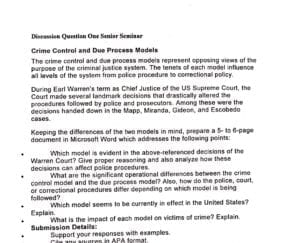Crime control and due process models
Crime control and due process models essay
APA format
Crime Control and Due Process
Herbert Packer constructed two models in 1968 to represent two competing systems of values operating within the criminal justice network, the crime control model and the due process model.
Clearly, these two models represent competing philosophies. The due process model emphasizes an obligation to protect the rights of citizens, even to the extent that doing so might limit law enforcement. Finding a balance between the two ideals is an ongoing struggle.
During the 1960’s, the Supreme Court made a series of decisions that emphasized a focus on due process, such as Mapp v. Ohio, Gideon v. Wainwright, and Miranda v. Arizona. These decisions limited the abilities of law enforcement by forcing police and prosecutors to adhere to strict due process requirements.
Not long after, the Court also decided several cases that similarly affected corrections. After many years of a “hands-off” attitude, the Court applied the due process model to correctional facilities, guaranteeing certain rights except when those rights contradict “legitimate penological objectives.”
However, in the decades that followed, we have seen movement toward the crime control model. Court decisions allowing warrantless use of GPS devices, legislation allowing indefinite detention in the interest of “national security,” and the developing practice of using drones to conduct surveillance indicate a renewed emphasis on crime control.
At the same time, sentencing trends show that the crime control model is also in place in the corrections area. We will review those trends in Week 3.
Understanding the difference between these two models, and how they affect practices and policies, is very important. In this age of terrorism, gang violence, and other security threats, the temptation to move toward crime control policies continues to grow. At the local level, we can see how some police departments lean toward crime control, with policies such as stop-and-frisk.
Answer preview to crime control and due process models
APA
1618 words



